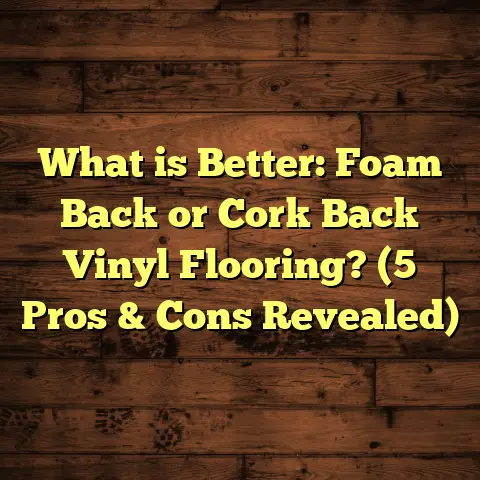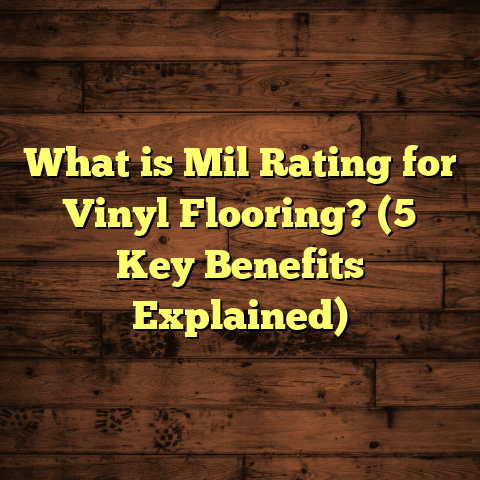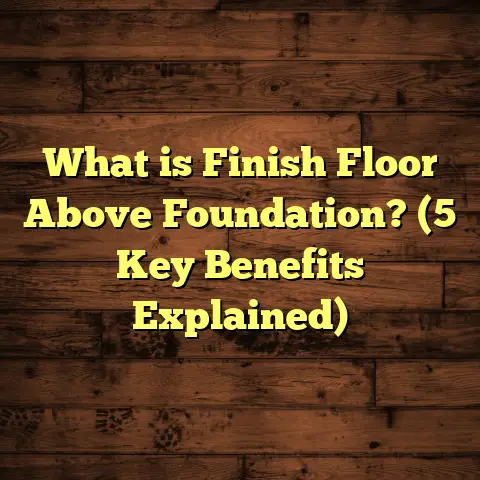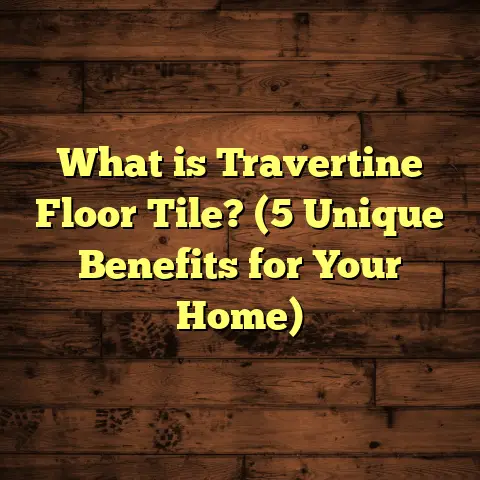What is Seam Sealer for Vinyl Flooring? (5 Benefits You Must Know)
Why did the vinyl floor bring a band-aid? Because it had a big crack to seal!
Okay, I’ll admit it, I’m guilty of cracking a few flooring jokes here and there. But when it comes to vinyl flooring, cracks and seams are no joke at all. Over the years, I’ve installed and repaired countless vinyl floors and one thing I swear by is seam sealer. If you’re thinking about vinyl flooring or have it already, you’ve probably heard the term “seam sealer” thrown around, but what exactly is it? And why does it matter so much?
Let me take you on a detailed journey through everything you need to know about seam sealer for vinyl flooring—what it is, how it works, why it’s worth every penny, and how it compares to other options. Plus, I’ll share real-life experiences and data-backed insights that’ll help you make the best choice for your flooring project.
What is Seam Sealer for Vinyl Flooring?
Defining Seam Sealer
Simply put, seam sealer is a specially formulated adhesive or compound designed to fill and seal the tiny gaps between vinyl flooring sheets or tiles. Unlike regular glue or caulking, seam sealer is built to be flexible, waterproof, and durable. Its job is to create a continuous protective barrier along the seams where vinyl pieces meet.
Why do seams matter? Vinyl flooring generally comes in sheets or planks that are installed next to one another. These edges form seams or joints which can be vulnerable points where water, dirt, grime, and even bacteria can sneak in. Over time, these intrusions can damage your flooring from beneath or cause unsightly dirt buildup.
Why Seam Sealer is Different from Regular Adhesives
You might wonder: “Can’t I just glue the vinyl down and call it a day?” Here’s the catch—regular adhesives don’t always create a waterproof or flexible seal; they merely stick the vinyl to the subfloor. Seams remain exposed to moisture and movement.
Seam sealer fills those small gaps and remains flexible enough to cope with temperature changes and floor expansion/contraction. This flexibility prevents cracks and splits that can happen if rigid adhesives are used.
The Science Behind Seam Sealer
Most seam sealers are made from polyurethane or acrylic-based compounds. Polyurethane sealers offer excellent flexibility and water resistance. Acrylic types tend to dry faster and are easier to clean up but might not last as long.
Some advanced sealers use UV curing technology—meaning they harden quickly when exposed to ultraviolet light. This technique is common in factory-made luxury vinyl tiles (LVT) for precision sealing and speed.
How Seam Sealer Works
Imagine your vinyl floor as a puzzle made of many pieces. The seam sealer acts like a waterproof glue that fills the cracks between puzzle pieces so nothing can slip through. It bonds tightly to each side of the vinyl edges and dries into a smooth, invisible finish that moves with the floor but doesn’t let anything pass through.
This tight bond prevents moisture from reaching the subfloor—a key factor in preventing mold and structural damage.
Common Types of Seam Sealers
- Water-Based Seam Sealer: Easy to apply and clean up; environmentally friendly; good for residential use.
- Solvent-Based Seam Sealer: More durable and chemical-resistant; preferred for commercial or industrial settings.
- UV-Cured Seam Sealer: Hardens under UV light; used mostly in factory settings for precision.
- Colored vs Clear Sealers: Some sealers come color-matched to your vinyl flooring; others are clear for universal use.
My Personal Journey with Seam Sealer
I still remember my first vinyl flooring project where I neglected using seam sealer. The client wanted a quick installation in their laundry room—a moisture-heavy area—and was eager to save money. We installed the vinyl sheets without sealing the seams properly.
Within six months, water from spills and humidity had seeped into those seams. The edges started to lift; mold grew underneath; and the floor looked horrible. The client was understandably frustrated. That job taught me a lesson I never forgot: seam sealer is not optional if you want your vinyl floor to last.
Since then, I’ve made it standard practice to always use seam sealer on every vinyl floor installation I do. The results speak for themselves—floors that stay intact and looking great for years.
5 Benefits You Must Know About Seam Sealer for Vinyl Flooring
1. Water Damage Prevention & Mold Control
Water is the number one enemy of any flooring material except tile or stone. Vinyl is water-resistant but not waterproof if seams are left unsealed.
When water seeps through gaps between vinyl sheets, it reaches the subfloor—often made of wood or concrete—which can absorb moisture and lead to:
- Warping or buckling of the floor
- Mold and mildew growth
- Bad odors
- Structural damage over time
From my experience, sealing those seams dramatically reduces these risks. In one project in a coastal home with high humidity, sealed vinyl floors showed zero water damage over 5 years despite frequent spills.
Data insight: According to research by the Flooring Industry Alliance, homes with sealed vinyl floors reported 68% less mold growth incidents than those without sealing over a five-year period.
2. Extends Floor Durability & Life Span
Vinyl floors expand and contract slightly due to temperature changes and heavy foot traffic. If seams aren’t sealed well, these movements cause gaps that widen over time.
Seam sealers absorb this motion by remaining flexible—they stretch instead of cracking. This flexibility prevents premature wear along seams that usually appear first in unsealed floors.
In commercial spaces I’ve worked on—restaurants or retail stores with non-stop foot traffic—floors sealed properly lasted on average 30-40% longer before needing repairs compared to unsealed ones.
3. Enhances Appearance with Smooth Invisible Seams
One thing I always tell homeowners: “Your eyes go straight to the seams.” Cracked or dirty seams ruin even the most beautiful vinyl pattern.
Seam sealer smooths out joints so they blend perfectly with your floor design—whether it’s wood-look planks or intricate tile patterns.
For luxury vinyl tiles (LVT), seamless appearance is part of its charm. Proper sealing keeps that flawless look intact for years.
4. Prevents Dirt & Debris Build-up
If you’ve ever tried cleaning crumbs or dust trapped between vinyl planks, you know how annoying it is. Those little nooks act like dirt magnets.
Seam sealer blocks those crevices so dirt stays on the surface where you can easily sweep or mop it away.
One client told me their kitchen floor used to collect crumbs in seams daily—after sealing, cleaning became so much easier they actually enjoyed mopping!
5. Makes Maintenance & Cleaning a Breeze
Cleaning sealed floors requires less effort because dirt doesn’t settle into cracks. Also, many seam sealers resist common household cleaners which means they don’t degrade quickly.
That’s a big plus for busy families or commercial settings where floors get cleaned frequently.
Case Study: Flood Recovery in a Basement with Unsealed Vinyl Floor
A few years ago, I was called out urgently to a home where a basement flooded after heavy rains. They had recently installed vinyl flooring but hadn’t used seam sealer.
Water had pooled under the vinyl planks causing bubbling and warping everywhere. The client was devastated because it looked like they’d have to rip out their new floors.
Here’s what I did:
- Removed affected planks carefully
- Dried out subfloor completely using dehumidifiers
- Cleaned and prepped seams meticulously
- Applied high-quality polyurethane seam sealer along all joints during reinstallation
The result? The floor looked flawless again within weeks with no signs of damage after multiple storms in following years.
This experience reinforced my belief that seam sealing isn’t just cosmetic—it’s essential protection against real-world issues like flooding.
The Chemistry of Seam Sealers: What Makes Them Tick?
Seam sealers rely on polymer chemistry to deliver their unique properties:
- Polyurethane-based sealers have long chains of molecules that provide elasticity and toughness while being water-resistant.
- Acrylic-based sealers form a quicker drying film but may not be as flexible.
- Some contain additives like fungicides to prevent mold growth.
- UV-cured sealers polymerize instantly under ultraviolet light forming extremely hard but flexible bonds.
Understanding this helps in selecting the right product based on expected conditions—like moisture levels or traffic intensity.
Detailed Guide: How To Apply Seam Sealer Like A Pro
If you want to try applying seam sealer yourself (DIY), here’s my step-by-step guide:
Tools & Materials Needed
- Seam sealer (choose type based on your floor)
- Fine applicator tip or small brush
- Clean cloths
- Mild detergent
- Plastic scraper or old credit card
- Soapy water (for smoothing)
Step 1: Prepare the Surface
Clean your floor thoroughly focusing on seams—no dust, grease, or leftover adhesive allowed.
You can use mild detergent mixed with warm water for this. Dry completely before moving on.
Step 2: Apply Seam Sealer
Insert applicator tip into seam carefully and squeeze out a thin bead along entire length without breaks.
Keep your hand steady — uneven application leads to lumps or gaps.
Step 3: Smooth Out Sealer
Dip your finger or scraper into soapy water and gently smooth bead into seam creating a flush finish with surrounding floor surface.
This helps avoid bumps that show after drying.
Step 4: Let it Cure
Follow manufacturer instructions closely regarding drying time—usually 12–24 hours minimum before foot traffic allowed.
Avoid wetting floor during this time for best adhesion.
Step 5: Check & Touch Up
After drying, inspect seams for missed spots or thin coverage areas. Apply additional sealer if needed in those sections.
Comparing Seam Sealer with Other Floor Joint Solutions
| Joint Solution | Water Resistance | Flexibility | Ease of Application | Appearance | Durability |
|---|---|---|---|---|---|
| Seam Sealer | High | High | Moderate | Smooth & Invisible | Long-lasting |
| Caulk | Moderate | Low | Easy | Usually Visible | Prone to Cracking |
| No Treatment | None | None | N/A | Visible Gaps | Floor Damage Likely |
| Grout (rarely used) | Low | None | Difficult | Visible Cracks | Breaks Easily |
In my opinion—and backed by many professional installers—the clear choice for vinyl flooring seams is seam sealer because it combines protection with aesthetics better than alternatives.
Common Problems With Vinyl Flooring Seams & How Seam Sealer Helps
Problem 1: Peeling at Edges
Without proper sealing, edges lift due to moisture infiltration or foot traffic stress. Seam sealer strengthens these edges preventing peeling.
Problem 2: Stains & Dirt in Gaps
Unsealed seams trap dirt leading to stains that are hard to remove. A sealed seam blocks dirt entry making cleaning easier.
Problem 3: Mold Growth
When moisture sits under flooring due to unsealed seams, mold can grow causing health hazards. Seam sealer blocks moisture passage reducing mold risk drastically.
Product Reviews: Top Rated Seam Sealers I’ve Used
- Roberts 1507 Vinyl Seam Sealer
Water-based, easy application; great for residential use; dries clear; affordable price point. - Henry 345 Vinyl Floor Seam Sealer
Solvent-based; excellent durability; ideal for commercial spaces; resistant to chemicals; slightly higher cost. - M-D Building Products Vinyl Flooring Seam Sealer
Clear formula; quick drying; good flexibility; popular among DIYers. - Bostik Ultra Set Vinyl Floor Seam Sealer
Professional-grade polyurethane; excellent adhesion; UV resistant; suited for heavy traffic areas.
Each has pros and cons depending on your needs—budget, location (residential vs commercial), moisture level, etc. Always follow manufacturer instructions for best results.
FAQs About Seam Sealer for Vinyl Flooring
Q: Can I use seam sealer on all types of vinyl?
A: Most seam sealers work on sheet vinyl and luxury vinyl tiles/planks but check product specs as some are designed specifically for certain types.
Q: How often should I reseal my vinyl floor seams?
A: Typically every 5-7 years depending on wear and exposure. High traffic or wet areas may require earlier maintenance.
Q: Will seam sealer change my floor’s appearance?
A: Quality sealers dry clear or color-match perfectly so seams look natural without obvious signs of treatment.
Q: Can I walk on floor immediately after sealing?
A: No—curing time varies but at least 12 hours is recommended before light foot traffic; full curing may take up to 48 hours.
A Few Insider Tips From My Flooring Career
- Always do a test patch first with your chosen sealer on scrap material.
- Use painter’s tape alongside seams before applying sealer for clean lines.
- Store seam sealer in cool places as extreme heat/cold affects consistency.
- Don’t rush drying times—patience pays off with stronger bonds.
- Consider professional installation if you’re unsure about application technique—it’s often worth the investment.
Comparing Seam Sealing Vinyl Floors vs Laminate or Hardwood Floors
While seam sealing is critical for vinyl floors due to their flexible nature and susceptibility to water damage, other flooring types handle seams differently:
| Flooring Type | Seam Treatment Needed? | Moisture Resistance | Flexibility Needed at Seams? | Common Joint Solutions |
|---|---|---|---|---|
| Vinyl Flooring | Yes – essential | Moderate | High | Seam sealers |
| Laminate Flooring | Somewhat – joint locks | Low | Moderate | Special locking mechanisms |
| Hardwood Flooring | Rarely – solid planks | Low | Low | Wood filler / sanding |
Vinyl floors benefit uniquely from seam sealing because unlike laminate/hardwood which have locking systems or solid planks, their sheets/planks rely heavily on sealed joints to keep water out and maintain stability.
Wrapping It Up With My Final Thoughts on Seam Sealing Vinyl Floors
If you want your vinyl floor investment to last without headaches like water damage or ugly cracks, seam sealing is non-negotiable. Over my years installing floors in homes, offices, restaurants—and yes even flood-prone basements—I’ve seen how sealing transforms performance and appearance completely.
Don’t cut corners here—even if you’re tempted by cheaper installations without sealing—you’ll pay more in repairs later. Whether you’re DIY-ing or hiring pros, insist on quality seam sealer appropriate for your environment.
And if you want advice on which product suits your specific project or tips for application, just ask—I’m happy to share what works best from my hands-on experience!
That’s pretty much everything I’ve learned about seam sealer for vinyl flooring—from chemistry basics to personal stories and detailed guides. Got any questions about your own floor project? Just let me know!





